Arto's Blog
| « Blog software upgrade helped with comment spam | Up and down the mountains in Northern Thailand and Laos » |
Sabai dii Pi Mai Lao
Posted: 2013-04-30 14:00:28, Categories: Travel, Cycling, Laos, 903 words (permalink)
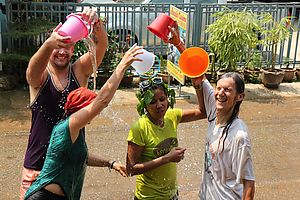 In Mid-April, in the town of Vang Vieng, we attended the cheerful
celebration of Pi Mai Lao, the Lao New Year. Hundreds of people poured
small buckets of water over us, wishing us Happy New Year. We joined
the teams by the roadside and did our own share of watering people
passing by. Beer Lao was generously offered to friends and strangers
alike, music was played from large loudspeakers all around the town
and everybody had a great time.
In Mid-April, in the town of Vang Vieng, we attended the cheerful
celebration of Pi Mai Lao, the Lao New Year. Hundreds of people poured
small buckets of water over us, wishing us Happy New Year. We joined
the teams by the roadside and did our own share of watering people
passing by. Beer Lao was generously offered to friends and strangers
alike, music was played from large loudspeakers all around the town
and everybody had a great time.
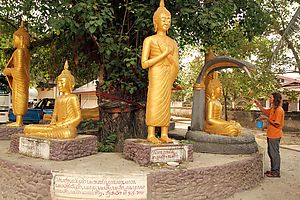 Traditionally, people prepare flowers and perfumed water which is
taken to temples and sprinkled over buddha statues. Some of the
water is carried back home and gently poured on relatives and
friends, to purify them and give a good start for the New Year. This
all still happens and the Buddhist New Year is a beautiful time to
visit a temple, stop for a prayer and do the ceremony following the
locals. We also did.
Traditionally, people prepare flowers and perfumed water which is
taken to temples and sprinkled over buddha statues. Some of the
water is carried back home and gently poured on relatives and
friends, to purify them and give a good start for the New Year. This
all still happens and the Buddhist New Year is a beautiful time to
visit a temple, stop for a prayer and do the ceremony following the
locals. We also did.
 A newer habit is to stand in small groups by the roadside, armed
with a garden hose, buckets and water guns, and to pour or throw
water on everyone who passes by. People in Laos usually drive small
motorcycles, which makes them good targets. Even the majority of
cars are pickups or half-open trucks, with people sitting in the
back unprotected from water. If someone doesn't like to get wet,
it's simply best to stay indoors. Most people don't mind, as it's
part of the New Year and the sun dries everything quickly
anyway.
A newer habit is to stand in small groups by the roadside, armed
with a garden hose, buckets and water guns, and to pour or throw
water on everyone who passes by. People in Laos usually drive small
motorcycles, which makes them good targets. Even the majority of
cars are pickups or half-open trucks, with people sitting in the
back unprotected from water. If someone doesn't like to get wet,
it's simply best to stay indoors. Most people don't mind, as it's
part of the New Year and the sun dries everything quickly
anyway.
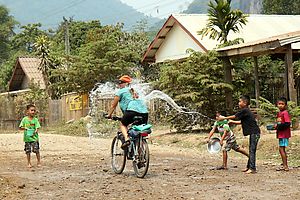 In the gentle and polite version of the New Year greeting, people
first wave the driver to stop. Then they pour a small amount of
water on the neck so that it runs down along the back, accompanied
with a cheerful wish of "Sabai dii Pi Mai", "Souksan van Pi Mai" or
"Suk dii Pi Mai", which translate to "Happy New Year" or "Good
luck for the New Year". If someone has a bag or something else which
shouldn't get wet, it can be lifted up so that no damage is done.
Especially elderly people were mostly greeted this way.
In the gentle and polite version of the New Year greeting, people
first wave the driver to stop. Then they pour a small amount of
water on the neck so that it runs down along the back, accompanied
with a cheerful wish of "Sabai dii Pi Mai", "Souksan van Pi Mai" or
"Suk dii Pi Mai", which translate to "Happy New Year" or "Good
luck for the New Year". If someone has a bag or something else which
shouldn't get wet, it can be lifted up so that no damage is done.
Especially elderly people were mostly greeted this way.
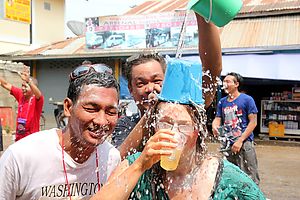 We as young foreigners on bicycles were naturally fair targets for
all variants of the game. Often we got several buckets of water
poured over us, followed by a glass of beer to drink, which we were
expected to finish before being allowed to ride forwards. Children
sprayed us with water guns, sometimes with water coloured in yellow,
green or red. A couple of times we also got white talcum powder
sprinkled on our heads. It was fun to ride around to see and feel
the party.
We as young foreigners on bicycles were naturally fair targets for
all variants of the game. Often we got several buckets of water
poured over us, followed by a glass of beer to drink, which we were
expected to finish before being allowed to ride forwards. Children
sprayed us with water guns, sometimes with water coloured in yellow,
green or red. A couple of times we also got white talcum powder
sprinkled on our heads. It was fun to ride around to see and feel
the party.
 When we wanted to play with water ourselves, we simply stopped at
one of the groups of locals by the roadside. They welcomed us
enthusiastically with an extra dose of water to make sure we'd be
wet enough, we got buckets, a bit of colour to the face and a glass
of beer, and were ready to join the team. So we also poured and
threw water on passers-by, on each other and on everybody around,
wished all Happy New Year and danced to the music. As for the beer,
we tried our best to drink a little bit with everyone while
avoiding to get too drunk. I'd say it worked out quite well.
When we wanted to play with water ourselves, we simply stopped at
one of the groups of locals by the roadside. They welcomed us
enthusiastically with an extra dose of water to make sure we'd be
wet enough, we got buckets, a bit of colour to the face and a glass
of beer, and were ready to join the team. So we also poured and
threw water on passers-by, on each other and on everybody around,
wished all Happy New Year and danced to the music. As for the beer,
we tried our best to drink a little bit with everyone while
avoiding to get too drunk. I'd say it worked out quite well.
 There were also many groups driving around in pickup trucks,
equipped with barrels full of water, buckets, water guns and
sometimes small water bombs. They engaged in water fights with other
pickups and with the teams by the roadside. Even a bigger truck with
a several thousand liter tank of water drove around spraying water
from a big hose. We heard that spraying water directly from garden
hoses and coloured water are actually forbidden, but nobody seemed
to mind. These were joyful water fights where everybody wins.
There were also many groups driving around in pickup trucks,
equipped with barrels full of water, buckets, water guns and
sometimes small water bombs. They engaged in water fights with other
pickups and with the teams by the roadside. Even a bigger truck with
a several thousand liter tank of water drove around spraying water
from a big hose. We heard that spraying water directly from garden
hoses and coloured water are actually forbidden, but nobody seemed
to mind. These were joyful water fights where everybody wins.
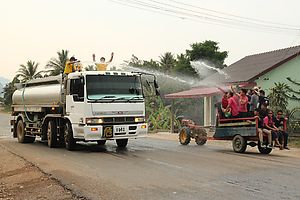 Officially the celebrations lasted for three days, from 14th until
16th of April. Some people started a day or two earlier, but 16th
was really the last day with water play. Eating, drinking and
dancing continued a day or two more, extending the party to a full
week. Most of the activity happened during daytime, from about 10 am
until 5 or 6 pm. In the evening nobody was throwing water any more:
it was time to sit down, eat and drink with friends. Music was
played at all times. In Laos nobody complains about loud music even
at night, especially not during New Year. Still, after 9 or 10 pm
most people went to sleep and it was already relatively quiet.
Officially the celebrations lasted for three days, from 14th until
16th of April. Some people started a day or two earlier, but 16th
was really the last day with water play. Eating, drinking and
dancing continued a day or two more, extending the party to a full
week. Most of the activity happened during daytime, from about 10 am
until 5 or 6 pm. In the evening nobody was throwing water any more:
it was time to sit down, eat and drink with friends. Music was
played at all times. In Laos nobody complains about loud music even
at night, especially not during New Year. Still, after 9 or 10 pm
most people went to sleep and it was already relatively quiet.
 We were impressed by the openness of people welcoming us, even
though we didn't know more than a couple of words of Lao and the
English abilities of our hosts were often on the same level. In
Germany or Finland strangers passing by would not be so easily
invited to join and warmly welcomed to a party. The attitude of the
Lao people was that shared fun is more fun, and everybody is
welcome. That's something we can also try to learn from them.
We were impressed by the openness of people welcoming us, even
though we didn't know more than a couple of words of Lao and the
English abilities of our hosts were often on the same level. In
Germany or Finland strangers passing by would not be so easily
invited to join and warmly welcomed to a party. The attitude of the
Lao people was that shared fun is more fun, and everybody is
welcome. That's something we can also try to learn from them.
Overall, the Lao New Year was one the funniest festivals we've ever been to. People were happy, playful and relaxed, having a good party mood. The water play was sometimes wild, but not rough. If we happen to be in Laos or Thailand (where the festival is called Songkran) in the future at the same time of the year, we'll certainly be on the streets again.
No feedback yet

Copyright Arto Teräs <ajt@iki.fi>, licensed under the Creative Commons Attribution-Share Alike 3.0 Unported License. (Unless otherwise mentioned in individual photos or other content.)